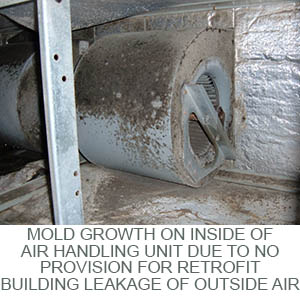
Indoor Environmental and Air Quality (IEAQ)

Indoor environmental quality (IEQ) and indoor air quality (IAQ) are frequently used and identified as synonymous. They are not. According to the Whole Building Design Guide, IEQ focuses on health, safety and comfort issues such as aesthetics, potable water surveillance, ergonomics, acoustics, lighting and other influences attributable to use and occupancy. IAQ speaks to the ASHRAE comfort parameters of the air (temperature, relative humidity, carbon monoxide and carbon dioxide levels compared to the outside), outside fresh air, particles, filtration and contaminants.
IEQ + IAQ = IEAQ
The Indoor Environmental and Air Quality (IEAQ – a term unique to BHS) in any building is a result of the interactions between the site location, climate, building systems, building materials alone and in assemblies, construction techniques and workmanship, construction scheduling, sequencing of trades, maintenance and operation, furnishings, moisture intrusion or unanticipated moisture events. Processes and activities within the building, use and occupancy, tenant-fit out, abatement and reconstruction, outdoor pollutant sources and building occupants are all factors that affect IEAQ in the built environment and create building dynamics. The EPA has ranked IEAQ among its top five concerns.
Indoor health concerns have increased as a result of energy conservation measures, tighter buildings and changes in building materials. New buildings do not present the same challenges as older buildings; the reverse is also true. IEAQ occupant complaints range from basic indoor comfort level issues to odd odors or conditions that may involve disease, illness and lost work time. Investigating IEAQ complaints requires a multi-disciplinary, health-based approach because of the complexity of variables and people involved.
IEAQ INVESTIGATION MODEL
At BHS, we have developed a fully integrated health-based investigation methodology based on the public-health model. Our physician specialists investigate the health concerns of the occupants or residents. At the same time, our building science professionals investigate building performance and integrity. This integrated approach has enabled BHS to resolve complex and challenging IEAQ problems successfully ensuring the health, safety and comfort of the building occupants.
IEAQ is a shared responsibility and represents an integrated, collaborative partnership between the construction professionals, building management and the occupants, or the homebuilder and homeowner in residential properties.